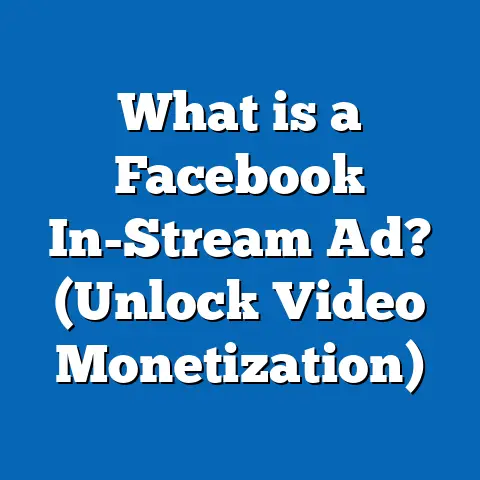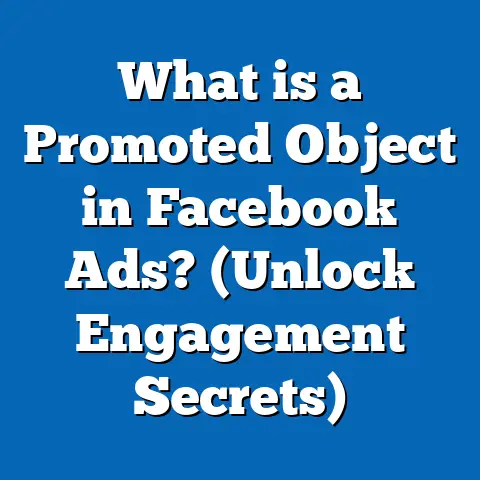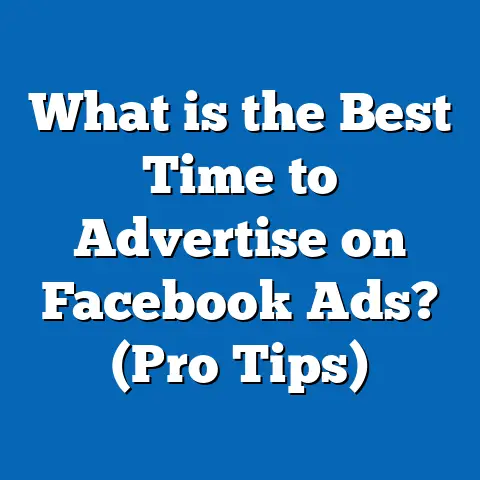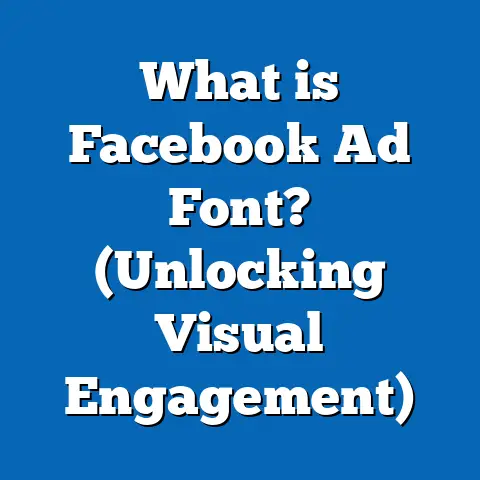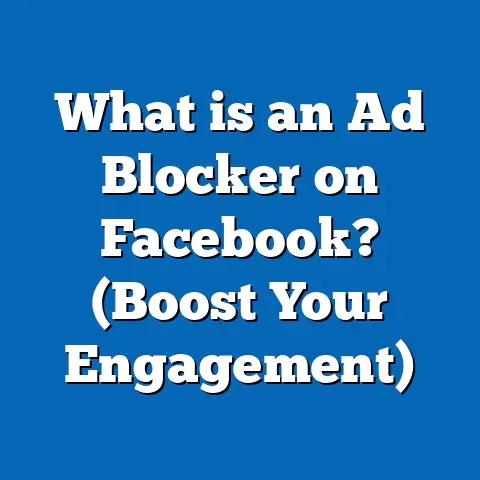What is Better Than Facebook Ads? (Uncover Top Alternatives)
What is Better Than Facebook Ads? (Uncover Top Alternatives)
Introduction: The Digital Advertising Odyssey
In the vast expanse of digital marketing, Facebook Ads have long been heralded as the go-to tool for businesses seeking to reach targeted audiences with precision. Much like the lighthouse that guides ships through turbulent waters, Facebook Ads have illuminated the path for countless marketers navigating the complex sea of online advertising. However, as the digital landscape evolves, new challenges and opportunities arise, prompting marketers to ask: Is there something better than Facebook Ads?
Understanding Facebook Ads: Strengths and Limitations
Why Facebook Ads Have Been Popular
Facebook’s advertising platform boasts over 2.9 billion monthly active users worldwide (Statista 2024), offering unparalleled reach. The platform’s targeting capabilities—based on demographics, interests, behavior, and custom audiences—have made it a favorite for businesses of all sizes. For many marketers, Facebook Ads provide a robust toolkit for brand awareness, lead generation, and sales conversions.
Key advantages include:
- Detailed Audience Targeting: Pinpoint users by age, location, interests, behaviors.
- Diverse Ad Formats: Image, video, carousel, collection ads.
- Robust Analytics: Real-time campaign tracking and optimization.
- Integration with Instagram and WhatsApp: Extended reach across Meta’s ecosystem.
Its ability to combine social interaction data with advertising means businesses can create ads that feel personalized and relevant.
Challenges Marketers Face with Facebook Ads Today
Despite its strengths, several factors have made Facebook Ads less effective or more costly for some advertisers:
- Rising Cost Per Click (CPC): The average CPC rose by 23% in 2023 (WordStream), driven by increased competition as more businesses move online.
- Ad Fatigue: Saturation leads to diminishing returns as audiences see the same ads repeatedly.
- Privacy Changes: Apple’s iOS 14+ update limits tracking accuracy by restricting third-party data sharing, reducing targeting effectiveness.
- Algorithm Complexity: Frequent algorithm adjustments make consistent campaign success harder to achieve without continuous testing.
- Audience Overlap: Many advertisers target similar demographics, driving up ad costs.
- Ad Account Bans & Policy Restrictions: Increasingly strict ad policies sometimes result in account suspensions without clear explanations.
These challenges have forced marketers to rethink their strategies and explore alternative or complementary advertising platforms.
Deep Dive: Facebook Ads Performance Metrics & Trends
Understanding why alternatives might outperform Facebook Ads requires examining key performance metrics:
| Metric | Average on Facebook Ads | Industry Variance |
|---|---|---|
| Click-Through Rate (CTR) | 0.9% | Higher in tech (1.5%), lower in finance (0.5%) |
| Cost per Click (CPC) | $0.70 – $1.50 | Retail: $0.70, Legal: $3.75 |
| Conversion Rate | 9.21% | E-commerce average |
| Cost per Acquisition (CPA) | $18 – $45 | Highly variable based on industry |
| Return on Ad Spend (ROAS) | Typically 4x – 8x | Depends on targeting and creative quality |
Source: WordStream 2024
While these numbers show potential profitability, they also highlight that success depends on ongoing optimization, creative freshness, and audience targeting accuracy.
Top Alternatives to Facebook Ads
To build a resilient marketing strategy that doesn’t rely solely on Facebook Ads, it’s essential to explore other platforms with distinct advantages.
1. Google Ads: The Intent-Based Powerhouse
Understanding Google Ads
Google Ads primarily targets users based on search intent. Instead of showing ads based on user interests or social profiles, Google captures demand at the exact moment users search for products or services.
Google’s network includes:
- Search Network: Text ads displayed on Google Search results.
- Display Network: Visual banner ads across millions of websites.
- YouTube Ads: Video ads on the world’s largest video platform.
- Shopping Ads: Product ads with images shown in search results.
Why Google Ads Often Outperforms Facebook for Direct Sales
The fundamental difference is intent. Users searching on Google are actively looking for solutions or products. This leads to higher conversion rates.
- Average conversion rates for Google Search ads are around 3.75%, higher than social media averages.
- Businesses earn about $2 in revenue for every $1 spent on Google Ads (WordStream).
Data-Backed Insights
A 2023 survey by eMarketer showed that 65% of consumers click on paid search ads when looking for a product or service online.
Case Study: E-Commerce Brand Boosts Sales by 40%
An apparel retailer shifted 40% of their ad spend from Facebook to Google Search campaigns targeting high-intent keywords such as “buy women’s summer dresses.” Within six months:
- Sales increased by 40%.
- Cost per acquisition dropped by 25%.
- Return on ad spend increased from 4x to 7x.
Practical Tips for Using Google Ads Effectively
- Focus on long-tail keywords to reduce CPC and increase relevancy.
- Use negative keywords to avoid irrelevant clicks.
- Implement conversion tracking through Google Analytics.
- Run A/B tests on ad copy and landing pages continuously.
- Use remarketing lists for search ads (RLSA) to re-engage visitors.
2. LinkedIn Ads: B2B Marketing’s Best Friend
The Professional Edge of LinkedIn
LinkedIn offers unparalleled access to professionals worldwide—ideal for B2B companies selling SaaS, consulting services, or high-value products.
Key targeting options include:
- Job title
- Company size
- Industry
- Seniority level
- Skills and groups
Why LinkedIn is More Effective for B2B than Facebook
Facebook’s audience is broad but less professional-focused. LinkedIn users expect business-related content and are often decision-makers themselves.
- Average CPC ranges from $5 to $8, higher than Facebook but justified by lead quality.
- According to LinkedIn data, 80% of B2B leads come from LinkedIn over other social platforms.
Case Study: SaaS Company Generates High-Quality Leads
A software firm targeting CIOs and IT managers ran Sponsored InMail campaigns with personalized messages.
Results after 3 months:
- Qualified leads increased by 30%.
- Lead conversion rate improved by 20%.
- Cost per lead was 15% lower compared to previous Facebook campaigns.
Best Practices for LinkedIn Ads
- Use clear value propositions in your messaging.
- Experiment with Sponsored Content vs InMail campaigns.
- Target specific industries or company sizes with tailored creatives.
- Utilize LinkedIn Lead Gen Forms for easy capture without leaving the platform.
3. TikTok Ads: Capturing the Gen Z Wave
Why TikTok Is a Game Changer
TikTok’s explosive growth has made it a must-consider platform for brands targeting younger consumers. Its unique algorithm promotes viral content that can deliver massive exposure quickly.
Key features include:
- Short-form video ads blending into organic content
- Branded hashtag challenges encouraging user participation
- Advanced targeting by demographics and interests
- Audience skewed towards ages 16–34
Engagement & Performance Data
TikTok reports engagement rates nearly twice those of Instagram or Facebook.
- Average CTR: 1.5% (versus Facebook’s 0.9%)
- Average watch time per video is over 15 seconds—high for digital video ads.
Case Study: Beauty Brand’s Viral TikTok Campaign
A beauty brand combined influencer partnerships with paid TikTok ads around a new product launch.
Outcomes:
- Website traffic rose by 60%
- Sales increased by 35% among the Gen Z demographic
- The campaign generated over 50 million organic video views alongside paid reach
Tips for TikTok Advertising Success
- Embrace authentic, creative content rather than polished ads.
- Partner with relevant influencers to boost credibility.
- Use trending sounds and hashtags strategically.
- Focus on product demos or storytelling within the first few seconds.
4. Pinterest Ads: Visual Discovery for Niche Markets
Pinterest as a Visual Search Engine
Pinterest users often browse with intent to plan purchases or projects such as home renovations, weddings, or fashion.
Key benefits:
- Over 450 million monthly users
- Strong purchase intent—83% of weekly Pinners have bought something based on Pinterest content
- Lower CPC than Facebook by approximately 20%
Data Supporting Pinterest’s Effectiveness
Pinterest reports that users save over 240 billion Pins focused on ideas and products, indicating strong user interest in discovery and inspiration—a perfect match for lifestyle brands.
Case Study: Home Furnishing Retailer Boosts Sales
A home decor retailer focused on Pinterest advertising targeting DIY enthusiasts:
- Increased online sales by 25% within four months
- Achieved CPA 15% lower than comparable Facebook campaigns
- Saw 3x increase in referral traffic from Pinterest versus prior months
How to Maximize Pinterest Ads
- Use high-quality vertical images optimized for mobile
- Target keywords related to products or projects
- Experiment with promoted video pins for storytelling
- Leverage shopping pins linked directly to product pages
5. Twitter Ads: Real-Time Engagement and Conversation
Twitter’s Unique Proposition
Twitter thrives on real-time conversations around trending topics, events, and breaking news.
Ad formats include:
- Promoted tweets
- Promoted accounts
- Promoted trends (top-of-feed placements)
Twitter Audience & Use Cases
With approximately 450 million monthly active users, Twitter is ideal for:
- Brand awareness during events
- Customer service engagement
- Driving conversations around product launches or announcements
Data Insight
Twitter reports that 75% of users have purchased a product after seeing a promoted tweet, demonstrating influence despite smaller audience size compared to Facebook.
Case Study: Consumer Electronics Launch Campaign
A tech brand used Twitter promoted trends during a product launch event:
- Achieved over 10 million impressions in one day
- Increased website visits by 40%
- Improved engagement rates by 50% compared to previous campaigns
Best Practices for Twitter Advertising
- Align ads with trending hashtags or topics
- Use concise messaging with strong calls-to-action
- Combine organic tweets with paid promotions for credibility
- Monitor real-time engagement and respond promptly
Emerging Platforms and Strategies Beyond Social Media
Programmatic Advertising: Automated Precision Targeting at Scale
Programmatic advertising uses AI-driven platforms to buy ad inventory across multiple websites and apps in real-time auctions.
Benefits include:
- Access to premium display inventory beyond social media
- Advanced targeting based on user behavior, context, location
- Automated optimization using machine learning algorithms
- Reduced manual effort in media buying
According to eMarketer:
Programmatic ad spending reached $140 billion globally in 2024 and continues growing at an annual rate of 12%.
Programmatic can complement social media campaigns by broadening reach while maintaining targeting precision.
Influencer Marketing: Authentic Reach Through Trust
Influencer marketing leverages trusted personalities with loyal audiences to promote products authentically.
Key stats:
- 63% of consumers trust influencer opinions more than brand advertisements (Edelman Trust Barometer).
- Micro-influencers (10k–100k followers) often deliver higher engagement rates at lower costs compared to mega-influencers.
Influencer marketing is effective on platforms like Instagram, TikTok, and YouTube but also can be integrated with paid ad campaigns for amplification.
In-depth Platform Comparison Table
| Platform | Best For | Avg CPC | CTR Average | Conversion Rate | Unique Strengths | Ideal Audience |
|---|---|---|---|---|---|---|
| Facebook Ads | Broad Reach & Retargeting | $0.70 – $1.50 | ~0.9% | ~9.2% | Detailed targeting & formats | B2C & B2B |
| Google Ads | Intent-Based Search | $1.00 – $2.00 | ~3.75% | High (~10%) | High conversion from intent | All |
| LinkedIn Ads | B2B Lead Generation | $5.00 – $8.00 | ~0.35% | Moderate (~6%) | Professional targeting | B2B |
| TikTok Ads | Gen Z & Millennials | $0.50 – $1.20 | ~1.5% | Moderate (~7%) | High engagement & virality | Youth & Lifestyle |
| Pinterest Ads | Visual & Lifestyle | $0.40 – $1.00 | ~0.6% | Moderate (~8%) | Purchase planning | Niche Markets |
| Twitter Ads | Real-Time Engagement | $0.50 – $2.00 | ~1% | Lower (~4%) | Trend-based conversations | Broad |
How to Choose the Right Alternative(s) for Your Business?
When exploring alternatives or complementing your existing Facebook Ads strategy, consider these steps:
Step 1: Define Your Advertising Goals Clearly
Are you aiming primarily for:
- Brand awareness?
- Lead generation?
- Direct sales?
Your goal will guide which platform works best.
Step 2: Understand Your Audience Deeply
Where does your target audience spend time online? What platforms do they trust? What type of content do they engage with?
Use customer surveys, social listening tools, and analytics data to map this out.
Step 3: Allocate Test Budgets Across Platforms
Start small but test across different platforms such as Google Search + TikTok + LinkedIn depending on your market segment.
Track performance metrics like CTR, CPA, ROAS rigorously.
Step 4: Prioritize Cost vs Quality Metrics
Low CPC doesn’t always mean better ROI if conversions are low quality or volume is insufficient.
Balance cost efficiency with lead or sales quality.
Step 5: Integrate Cross-channel Campaigns
Combine intent-driven search ads with brand-building social media campaigns for holistic marketing impact.
For example:
- Use Google Search ads to capture demand.
- Engage audiences via TikTok or Instagram stories.
- Re-target warm leads via Facebook or programmatic display ads.
Advanced Tips and Industry Trends to Stay Ahead
Leverage AI Tools for Campaign Optimization
Modern ad platforms integrate AI-powered tools that automate bidding strategies, audience segmentation, and creative optimization leading to better results at scale.
Privacy-first Marketing Strategies Are Critical Now
With ongoing privacy regulation changes (GDPR, CCPA) and platform restrictions (Apple iOS privacy updates), marketers must invest in first-party data collection via email lists, CRM integrations, and consent-based marketing.
Video Content Dominates Across Platforms
Video ads consistently outperform static images across all platforms—focus on storytelling videos optimized for mobile viewing under 15 seconds.
Omnichannel Marketing Is Key
Consumers interact with brands across multiple touchpoints before purchasing — integrating offline data with online campaigns improves attribution and personalization.
Conclusion: Diversify Your Digital Advertising Strategy for Future Success
Facebook Ads remain a powerful tool but no longer the only answer when striving for digital marketing success. The evolving landscape demands diversification—leveraging platforms like Google Ads for intent-driven traffic; LinkedIn for precise B2B outreach; TikTok for engaging younger audiences; Pinterest for niche lifestyle markets; and Twitter for real-time conversations can unlock new growth avenues.
Data-backed case studies reveal that combining these channels improves ROI while mitigating risks associated with dependence on any single platform. Emerging technologies like programmatic advertising and influencer partnerships add further layers of opportunity.
Marketers who define clear goals, understand their audience deeply, experiment strategically across platforms, and continually optimize campaigns will thrive in this dynamic environment.
Next Steps for Marketers and Business Owners
- Conduct an audit of your current Facebook Ad performance focusing on metrics like CPC, CPA, conversion rate.
- Identify pain points such as rising costs or plateauing results.
- Select one or two alternative platforms aligned with your product type and audience profile.
- Launch pilot campaigns with well-defined KPIs.
- Use analytics tools (Google Analytics, platform dashboards) to track performance daily.
- Scale investment into winning channels while refining creatives and targeting.
- Explore advanced options like programmatic display or influencer collaborations as budgets grow.
- Stay abreast of privacy regulations impacting data collection and targeting capabilities.
- Continuously refresh ad creatives and messaging based on performance insights.
- Maintain an omnichannel mindset integrating all digital touchpoints into cohesive customer journeys.
Implementing these steps will position your brand not just as a follower but as a leader in digital advertising innovation beyond Facebook Ads.

